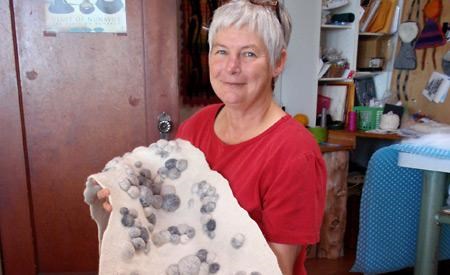What does an electrical engineer do when she applies her skills to fabric arts? In the case of Texada Islander Deb Dumka, 58, she incorporates effects like lighting and the sounds of nature into three-dimensional handfelted carpets.
Her work has evolved considerably since she sewed her first button on a doll at age four. Now Dumka is a nationally-recognized fabric artist who is president of the Canadian Crafts Federation (CCF).
Born in Kitimat, Dumka grew up in St. Lawrence, Newfoundland, a mining town of 2,000 people where her father worked as an electrical engineer. She recalls being fascinated with fabrics as a child. “How things felt interested me, as did how the visual texture of cloth changed with weaving or surface printing.” She discovered that she could transform something flat, cloth, into three-dimensional articles of clothing and she began sewing her own clothes.
Professionally, Dumka was inspired to follow her father’s career path and she earned a bachelor of engineering degree from Memorial University in St. Johns. She worked as an electrical engineer in Calgary and Vancouver, where she designed electrical control systems for unmanned submersibles. She also took courses in hand-spinning and natural dyes and met and married Vancouver geologist Mike Sanford, whose family had a summer home in Gillies Bay.
They moved to Hedley, BC, where Sanford was a geologist at the local mine and where their three daughters were born. Dumka borrowed a 100-year-old spinning wheel and began making yarn from mohair fibres. She experimented with blending fibres and spinning them into luxury yarns. She also worked with silk, wool and cotton fibres and had a loom at her in-home studio. She became proficient at sewing, knitting, dying, weaving, spinning and felting, a process of transforming wool fibres into a dense fabric that doesn’t unravel when cut. She calls it “massive entanglement.”
While in Hedley, Dumka also became active in community affairs and was elected to the Keremeos School Board, where she served from 1988 to 1992. “That experience taught me to not be afraid to get involved with things,” Dumka says. When the mine closed in 1992, the family moved to St. Johns where Sanford earned his teacher certification and Dumka took a two-year art-based textile studies program. She explored felting techniques and made a winter coat that was featured at an exhibition at the Textile Museum of Canada in Toronto. She joined the Newfoundland Crafts Development Association and her work was accepted into numerous juried exhibitions.
They returned to BC in 1994, where they lived temporarily in the Sanford summer home in Gillies Bay. After working as a teacher-on-call with the Powell River school district, Sanford was hired to teach at Van Anda School, which at the time had 155 students from kindergarten to grade 10. “Texada has lots of space to think and let ideas ferment,” Dumka says. They brought oceanfront property near Shelter Point Park and built a house with a large studio for Dumka. She brought her knitting machine and a supply of wool and began making and exhibiting her carpets at provincial shows. She won an award of excellence at a visual arts festival in Powell River.
She joined the Craft Council of BC, “because they looked after the welfare of crafts professionals,” and she’s been on its board of directors since 2005. She is the BC rep to the CCF and was elected its president in 2011. CCF will hold its annual conference in Vancouver next year, when Dumka hopes to incorporate a series of crafts exhibitions throughout BC, including Powell River. For that, she has embarked on the process of “animating” her textiles through the use of sounds and lights in her carpets, which already incorporate small stones for texture and a three-dimensional appearance. She wants to use sounds of nature to “bring the outdoor experience into indoor living space.
“Crafts organizations are working to shift the public perception of crafts as hobbies. Craftspeople are, in fact, small business people. Our goal is to create an environment which acknowledges craft as a legitimate field of endeavour and where people who choose to work in craft can have a viable existence. We all benefit from creative expression in ourselves and others.”
Currently, Dumka sells her work of handbags and felt jewellery in 12 galleries across Canada and at the Seattle Art Museum. Her work can be viewed online. She is preparing for a solo show of animated objects opening next August in Vancouver.



